On the surface, Encore Design is a new brand which is just entering into the booming market of autonomous audio convertors. However, Encore Design is actually the new brand name of the widely used NuForce products, which we have (on several occasions) honoured with a Qobuzism award in appreciation of their high quality.
Up until now, these top-of-the-range devices have been manufactured by the American brand known as 'Nuprime'.
However at this very minute, if you visit the Encore Design website you will discover the brand?s only currently available product, the mDAC, whose complete test we are going to present to you now.
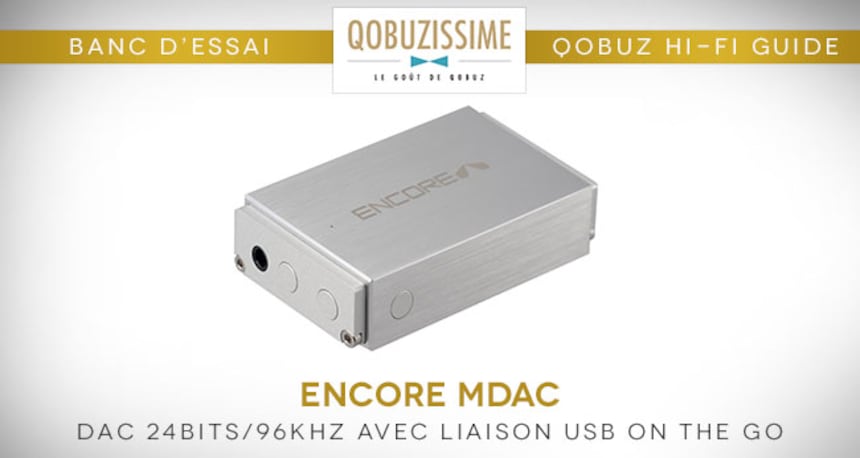
This small DAC of 24-bit/96kHz can not only be used with a PC or Mac computer, but is also compatible with an Apple/Android Smartphone or tablet. However the manufacturer does not specify this, since the device contains a USB OTG connection (On The GO, establishing a direct dialogue with the connected tablet or Smartphone), meaning that the mDAC will be powered by its internal battery in order to save the hosts battery.
About the mDAC Encore Design
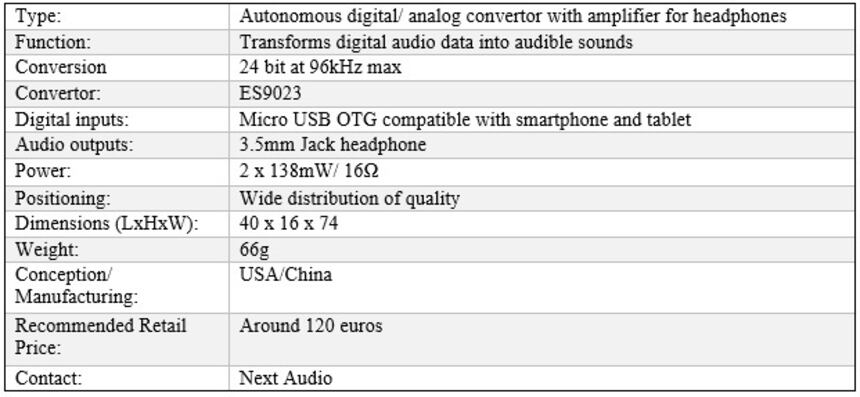
Presentation
The DAC has a simple geometric form with a rectangular body, adopting a natural or black anodized aluminium profile with tapered edges. The device is enclosed by a front panel, whilst the back face is made of resin and is the same colour as the body. Overall the mDAC is very pleasing to the eye!
To switch on the device you have to press down for several seconds on the button placed on the device?s right hand side. An LED light will appear (of a variable colour depending on the state of the device), along a small opening situated on the upper surface.
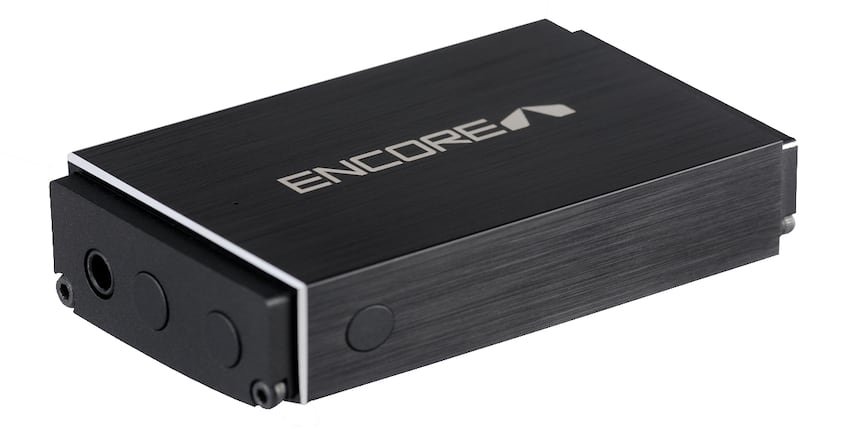
On the opposite side there is a 3.5mm jack socket, to connect a headphone, as well as two buttons enabling you to increase or decrease of volume. There are two micro USB sockets on the back face. On the right there is a standard USB connection, whilst left side enables you to recharge the mDAC?s battery.
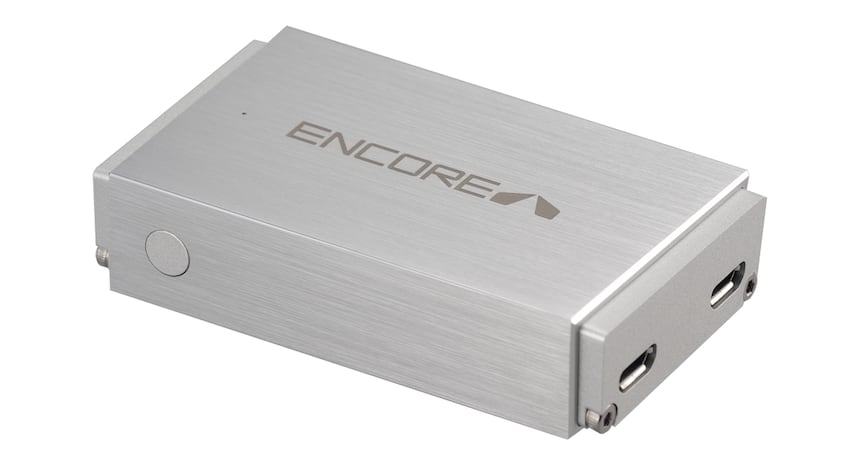
The Electronics
The card which comes standard with the mDAC contains almost all the components on its upper surface. The lower surface contains only a very, very small amount, because of the limited space available, due to its position in a chute at the bottom of the casing.
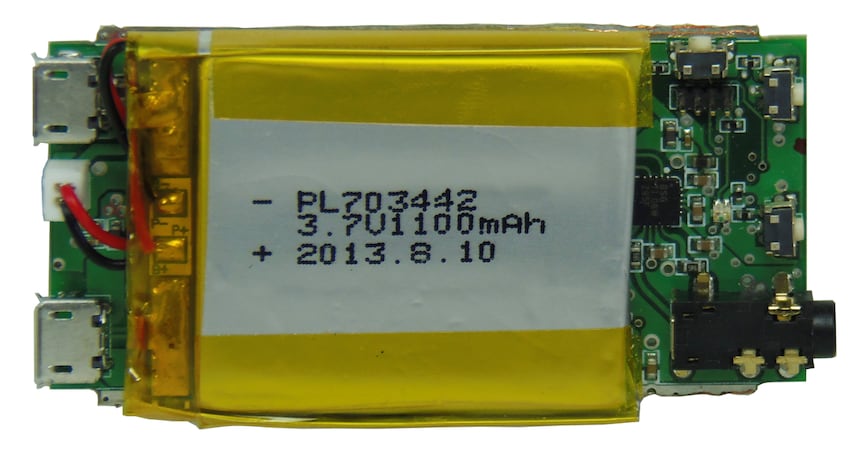
The rechargeable lithium battery delivers a voltage of 3.7V and has a capacity of 1100mAH. It is attached by a double-sided adhesive plate attached to the components on the upper face.
The battery has been removed in the image below, enabling you to see the card?s electronic equipment.
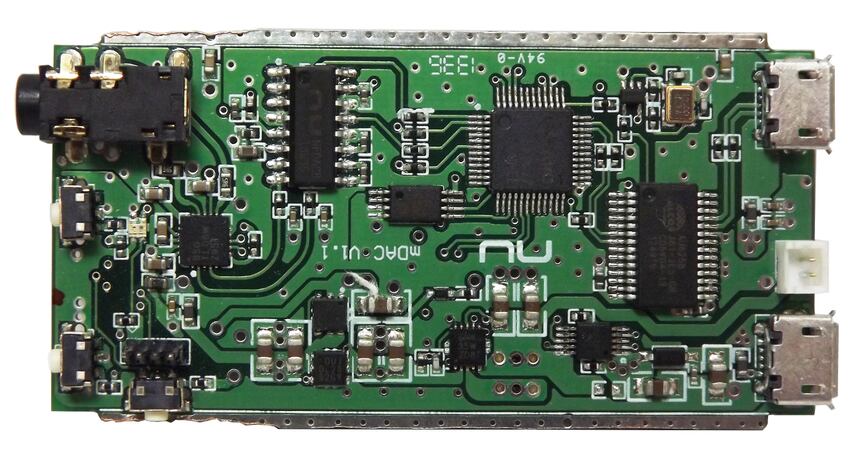
This is an Alcor AU6258 circuit, responding to high speed hub with USB 2.0 specifications, which ensure the USB interface (on the right of the photo, next to the connectors).
Further up on the left you can see a Savi Bravo SA9027 controller, compatible with audio files of 16, 24 and 32 bit. This has the sampling frequencies of 32, 44.1, 48, 88.2 and 96kHz. This socket is responsible for extracting the I2S bus flow of USB data.
This I2S bus is then transformed into an analog audio signal by the digital analog convertor situated on the left. This is a pressed NuForce model, with the reference NF DAC8 (but in reality the reference DAC ESS Sabre ES9023 manufactured by NuForce), which gives out signals referenced to the ground, thanks to its integrated ?charging pump?, generating a negative voltage.
One does notice the absence of an operational amplifier filter in the DAC output, which we won?t complain about, which indicates that it possesses its own filters with a switched capacitor (SCF: Switched Capacitor Filter).
The audio signals are thus supported by the Texas Instruments TPA6133A2 headphone amplifier. This possesses, like the DAC, a ?charging pump?, generating a negative voltage so that the audio signals are referenced to the ground, meaning that it is not necessary to use connecting condensers on the route of the audio signals.
The TPA6133A2 produces a power of 138mW in 16? and possesses an internal fixed gain at 4dB. The level adjustment is produced by an analogical digitally controlled attenuator (most likely at the DAC ES9023 level). In this way the manufacturer overcomes the differences of attenuation, which can sometimes appear between the tracks from a potentiometer.
Usage, listening
Firstly, we should clarify that the mDAC is DSD compatible, which we have checked and clarified with the manufacturer. The interfacing USB part and the digital/ analog convertor is very similar to that of the µDAC-3.
When we first listened to the mDAC it was a complete shock. We truly believe, and will state again, this is primarily due to the absence of feedback from the DAC (there is no operational amplifier filter after conversion, since the chip contains switched capacitor filters). In the case of the mDAC, the use of a headphone amplifier also adopts a different structure to that of an operational amplifier, creating these exceptional sound quality results.
We have also already commented on the beauty of the restitution created by the ESS chips. However the slightly artificial tone that sometimes appears at the top of the spectrum, which we have already remarked on, does not seem to be the case here. As we have already confirmed, the balanced restitution of the first movement of Beethoven?s Concerto for violin, with Vera Beths on the violin accompanied by the Tafelmusik ensemble, led by Bruno Weil, and superbly captures the flavour of the early musical instruments.
To summarize this device, since I first held this little marvel in my hands, I have already listened dozens of times to the magnificent performance of Vivaldi?s Dixit Dominus in Studio Masters 24 bit quality at 44.1kHz, with Rinaldo Alessandrini at the head of the Concerto Italiano. The recording?s superb sound is a delight to listen to.
The sound results are also miles ahead of the game when you listen with headphones, and when you directly attach the mDAC to active multi amplified speakers, which work like a preamplifier.
As my computer specialist colleague said, you are truly are ?inside? the sound. We don?t remember ever having heard a DAC with amplifier for headphones, which truly submerges you into the heart of the music, giving you the impression that the musicians are physically there with you, and that you are following the playing with a magnifying glass. When listening to Vivaldi?s Dixit Dominus, it is amazing to hear the attacks of the chords played by the brass. It is almost impossible to believe that all these things are created by this marvellous little magic box!
However, rest assured those of you who don?t listen to Vivaldi. Somebody to Love from Queen?s Platinum Collection benefits from the same exceptional sound treatment, creating an almost spiritual presence that fervently fills the room. However when listening to CrazyLittleThingCalled Love, a homage to Elvis Presley, the image of The King dressed in a black suit actually appears before your eyes, microphone in hand, (unless it is actually Freddie Mercury?)
To finish, when reproducing the DSD files, the device is just as excellent. However you should not mistake this with the (slightly complicated) configuration of the Foobar2000, whose link we have placed below.
To conclude, the mDAC Encore deserves not merely any Qobuzism, but a golden Qobuzism for this marvellous little music box that has truly delighted our ears, to the extent that we?re starting to wonder if we have been enchanted by some sorcery. Taking into account the price, which seems somewhat unbelievable, we cannot encourage you enough to go and treat yourself by listening to this truly astonishing mDAC!
Next Audio (Importateur)
Download ASIO drivers, plugin package and DSD Foobar2000
Tutorial DSD Playback on Foobar2000
Tutorial to send only music to the DAC with Foobar2000 and not all the sounds generated by the computer
Reading abilities
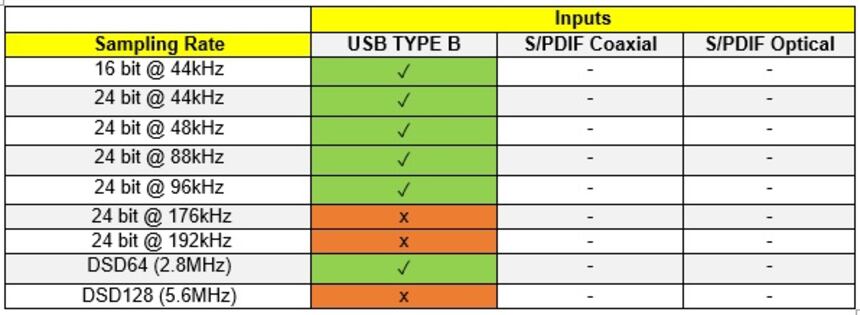
If you are a manufacturer, importer, distributor or actor in the domain of sound reproduction and you wish to contact us, please do so using the following address: newstech@qobuz.com
If you are passionate about our Hi-Fi Guide and you wish to contact us, please do so using the following address: rubriquehifi@qobuz.com

